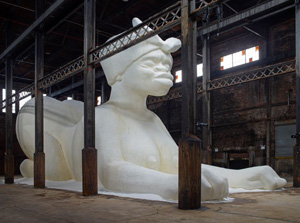2.10.25 — A Not So Subtlety
To wrap up from last time on black artists and ancient Egypt, the most potent ancient imagery cannot reduce past or present to a stereotype of greatness. Good art cannot appropriate tragedy on behalf of uplift. Rather, it returns quite literally from the grave to haunt the present.
Those black kids at the Met may have loved its Egyptian tomb as much as I did as a child, and so surely did Lauren Halsey. Just a summer ago, she took her version of the tomb upstairs for summer sculpture on the Met roof. It may have seemed awfully straightforward, like a recitation in school,  but it evoked, her title explains, the east side of South Central LA. It was the story of her life, retold once more in a colorful collage on two square pillars here.
but it evoked, her title explains, the east side of South Central LA. It was the story of her life, retold once more in a colorful collage on two square pillars here.
A full third of the show builds a scholarly history of greatness. If that sounds like a well-researched scam, then come kings and queens who cannot return from the dead. They can, though, learn from children, on a class trip or in O’Grady’s family album. Lonnie Holley transforms deities flanking a pharaoh’s tomb into very real, heavily swaddled children. If they seem one part comforted and one part repressed, so, they seem to say, are black families even today. When Betye Saar paints Window of Ancient Sirens, a triptych after a funerary mask of King Tut, she seems more disturbed than impressed.
Not that the accent is on subtlety. There is always the good cheer of Pop Art for Robert Colescott or the glorified street art of Jean-Michel Basquiat. Kara Walker, though, subtitled her grandest public work A Subtlety, and she was not altogether ironic. For all its scale and glowing whiteness, it had black features far from an Egyptian sphinx. And she made it of sugar, like a product of the Domino Sugar plant displaced by gentrification right next door—or of slave labor in the Caribbean. The Met can include only a sketch, a quick one at that, but it will do.
Ancient monuments appear again in contemporary settings, but in miniature, as collectibles. How better for the oldest intercollegiate black fraternity to assert its identity than on boardroom shelves, in a painting by Derek Fordjour? How much better still to explore blackness than with actual shelves on a large field of black soap from Rashid Johnson? David Hammons creates his own pyramids of human hair, while Sam Gilliam creates his in Minimalist aluminum, wood, white, and blue. Maren Hassinger make her Love (Pyramid) both sculpture and performance, in pink balloons. While not much to do with Egypt, Terry Adkins still pays tribute to Carver’s oxidized blue.
Art for art’s sake or history’s makes only a fleeting appearance before the show’s final third, about music. It includes album covers, lots of them, and a space for Afrofuturism, which somehow includes Julie Mehretu, the abstract artist, along with Sun Ra in jazz. And who could deny the impact of African American musicians? Still, album covers can take things only so far, and references to Egypt seem no more than coincidental. Besides, the Met already installed a period room for Afrofuturism in 2021. To misquote Sun Ra, space here is no longer the place.
This is an enormous show for so tenuous a theme. It will be fine for those who seek only role models in the terror and turbulence of history. As a handy survey of contemporary black art, it cannot match a larger and smarter show centered on Alvin Ailey, the choreographer, at the Whitney. Not that it lacks for artists and anecdotes worth knowing, not by any means. Who could imagine that William T. Williams found inspiration for his gray diagonals in Nu Nile, a black hair-care product? There may be gray areas left in a field of black and white, but a museum owes art more than a royal mess.
Read more, now in a feature-length article on this site.